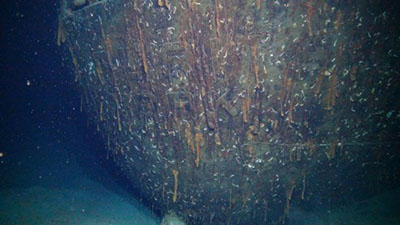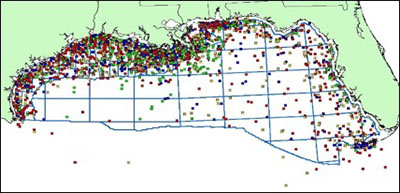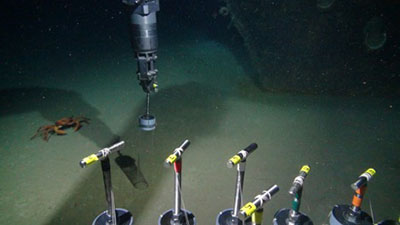
By Dr. Leila Hamdan
Associate Professor
School of Ocean Science and Engineering, University of Southern Mississippi

Close-up view of the stern of the Alcoa Puritan shipwreck, located at ~2,000 meters (~6,500 feet) depth in the Gulf of Mexico. The 77-year-old shipwreck holds information about maritime history and hosts diverse biological life, both visible and invisible. Image courtesy of Hamdan Lab, image collected by the Odysseus ROV in September 2018. Download larger version (jpg, 105 KB).
A stowaway hides aboard a vessel as a means of free travel. During a nine-day expedition in the northern Gulf of Mexico led by the University of Southern Mississippi (USM) in collaboration with the Bureau of Ocean Energy Management (BOEM), scientists will aim to discover and characterize two unexplored, wooden-hulled shipwrecks in the Gulf of Mexico and study the microbial stowaways living secretly on and around the wrecks, to learn how shipwrecks shape the microbial biodiversity and biogeography of the deep sea.
During this expedition from June 24 to July 3, 2019, supported by the NOAA Office of Ocean Exploration and Research on board USM’s research vessel (R/V) Point Sur, our team of interdisciplinary scientists and educators will conduct a complete archaeological investigation of the sites using a remotely operated vehicle (ROV). The team will also use the ROV to deploy seafloor landers—devices used to conduct experiments on the seafloor and then float them back to the surface once the experiments are done. Sediment cores will also be collected around the shipwrecks to help learn if the shipwrecks enhance biodiversity on the seafloor. The landers, which have wooden surfaces to capture and grow biofilms, will determine if “microbial stowaways” are present and using the shipwrecks to travel across the seafloor. It is known that shipwrecks host macro-organisms (e.g., fin fish, coral, tube worms), and help them disperse across long distances. Our work may reveal if shipwrecks impact microbial community ecology in similar ways. Our project is equal parts marine archaeology, microbial ecology, and discovery.
Our team includes eight scientists from USM and the U.S. Naval Research Laboratory, two archeologists from BOEM, four ROV crew members, an outreach specialist from USM’s Marine Education Center, and a middle-school teacher from the NOAA Teacher at Sea program. Our project would not be possible without the support and innovation of the crew members of R/V Point Sur.

R/V Point Sur at its homeport of Port of Gulfport. Image courtesy of Microbial Stowaways. Download larger version (jpg, 398 KB).
There are ~2,000 known historic shipwrecks in the Gulf of Mexico. The ones that are greater than 50 years old are considered historic and are protected under the National Historic Preservation Act. The wooden shipwrecks in the Gulf of Mexico can be viewed as a museum of maritime history and past economies. They also become artificial reefs and pockets of biodiversity shaping life in the deep ocean. While much of the life on shipwrecks is visible to the eye, our research focuses on the invisible and extraordinarily diverse microorganisms that live in these charismatic and hard-to-reach places. Our work merges archaeology, biology, geology, and computational science and aims to provide information about the cultural history of two newly discovered shipwrecks and how they shape life in the deep sea.

The location of known historic shipwrecks in the Gulf of Mexico. Colors represent different degrees of position accuracy connected to each site in the BOEM database. Green = position confirmed; Yellow = position accuracy is good; Blue = position accuracy fair to poor; Red = position accuracy poor. Image courtesy of BOEM. Download larger version (jpg, 107 KB).

Sediment samples collected near the bow of the Anona shipwreck, with a local crab supervising the operation. Samples during this study will be collected with these push corers. Image courtesy of Hamdan Lab, image collected by the Odysseus ROV in September 2018. Download larger version (jpg, 76 KB).